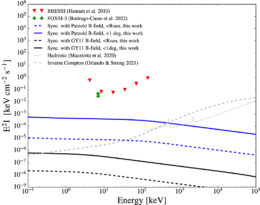Solar flares and massive coronal explosions get all the attention, but the quiet Sun is interesting in its own right. Two recent research articles explore new phenomena that have come to light when the Sun is at its calmest.
WINQSE from the Sun
When the Sun releases a solar flare, fast-moving electrons accelerated by the flare spiral around solar magnetic field lines. This process produces short bursts of radio waves called radio transients. Even when the Sun is quiet, though, with no solar flares or other activity, researchers have detected brief flashes of radio emission lasting less than a second. These fleeting radio sparks might be the counterpart to a special kind of solar flare: a nanoflare.
Although nanoflares are thought to have the same basic cause as solar flares (the release of pent-up magnetic energy), they are far less powerful. Less powerful, but more frequent: in theory, nanoflares might flicker on the Sun’s surface almost constantly, providing a steady source of heat to the Sun’s rarefied upper atmosphere, or corona. Nanoflares are a potential solution to what is known as the coronal heating problem — the challenge of heating the solar atmosphere from ~6000K near its surface to millions of kelvin in the corona.

Radio contours (black lines) corresponding to an individual WINQSE observed at a frequency of 136 megahertz (wavelength of 2.2 meters). The background image shows the Sun at a wavelength of 19.3 nanometers. [Mondal et al. 2023]
Using the Murchison Widefield Array in Western Australia, the team once again detected numerous WINQSEs and characterized their properties. These observations confirmed that WINQSEs are extremely fast, with most events likely shorter than the 0.5-second cadence of the observations, and they appear all across the Sun. As the body of WINQSE observations grows, Mondal and coauthors hope that interest in these fleeting events will grow as well, spurring the community toward a greater understanding of this phenomenon.
Emission from Spiraling Electrons
On the theoretical side, a team led by Elena Orlando (University of Trieste, Italy; National Institute for Nuclear Physics and Trieste Observatory of the Italian National Institute for Astrophysics) explored another phenomenon: emission from galactic cosmic rays tangled in the Sun’s magnetic field. Galactic cosmic rays aren’t “rays” at all, but rather high-energy charged particles thought to be accelerated in distant cosmic engines like supernovae. When galactic cosmic ray protons or atomic nuclei reach the Sun, their interactions with solar photons and the solar atmosphere generate high-energy emission. This process occurs during active and quiet times on the Sun.

Modeled flux (solid and dashed lines) compared to observational upper limits (red and green symbols). The blue and black lines use different models for the Sun’s magnetic field, and the results are shown integrated over the Sun’s disk (dashed) and integrated over a 1-degree circle centered on the Sun’s disk (solid). The grey lines show the modeled emission strengths for other processes related to galactic cosmic rays. Click to enlarge. [Orlando et al. 2023]
The team used existing measurements of inbound galactic cosmic rays and models of the Sun’s magnetic field to model the strength of the emission as a function of location and wavelength. They found that the emission is essentially constant across the Sun’s disk and is brightest just beyond the edge of the disk, where the magnetic field is strongest. They found that the Sun’s thermal emission far surpasses the expected emission from swirling cosmic ray electrons at wavelengths from radio to ultraviolet, but at higher energies, things seem more promising: while the emission strengths are well below upper limits previously measured, instruments like the Focusing Optics X-Ray Solar Imager (FOXSI) or the Nuclear Spectroscopic Telescope Array (NuSTAR) might be sensitive enough to track it down.
Citation
“Study of Radio Transients from the Quiet Sun During an Extremely Quiet Time,” Surajit Mondal et al 2023 ApJ 943 122. doi:10.3847/1538-4357/aca899
“A New Component from the Quiet Sun from Radio to Gamma Rays: Synchrotron Radiation by Galactic Cosmic-Ray Electrons,” Elena Orlando et al 2023 ApJ 943 173. doi:10.3847/1538-4357/acad75
